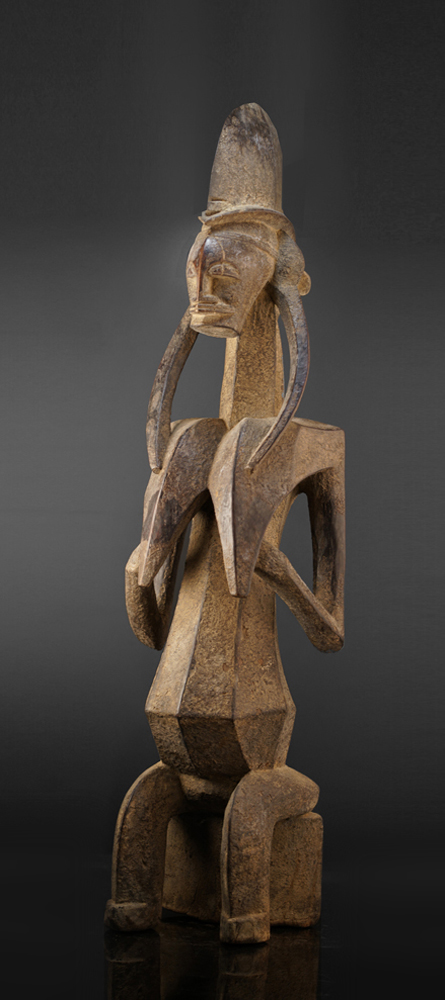|
A Bamana Gwandusu Araba seated on a one leg stool, the hands touching the hanging, curved breasts, the carver is called "Fana", the sculpture was collected at the Toubakoro village, about 70 km from Segou of the Western side of the Niger river. According of our fieldwork in this region "the Gwandusu Araba is the only Gwandusu without a child and is extremly rare. During a discussion about the origin of a Malinke related Bamana couple Kate Ezra wrote me in May 2005: „It is often difficult to pinpoint the origin of Bamana objects. Both - Sarah Brett-Smith and Kate Ezra - emphasize that they can only make statements about the (Bamana) regions in which they have done fieldwork. Nevertheless styles were mostly assigned in the past to those places of researches and not of the places, where they are collected. This fact is based on the particularity that works of tribalart are „travelling“ in Africa from one remote area to another before they appear in the Western world. The informations about the provenance, which are accomanying these ritual remnants, is normally more than doubtful, because the question of an African provenance was nearly never of great interest for collectors, who were looking more for esthetic value than african provenances. Under this aspect the exhibition of the Rietbetg Museum was an important priority for a new view, which Africa and its cultural tradition is focusing. Height: 98 cm sold |  photo: tribalartforum.com/ identification no. |
Using the example of a known Bamana sculpture of the Met and two sculptures and a mask, which are collected recently the relationships of style and origin are significantly. Quoting the informations about this sculpture is notified in the description: "Figures like these appear in the annual celebrations of Jo, an association of initiated men and women living near the towns of Bougouni and Dioïla in southern Mali.“ A Gwandusu Araba of the same village like the sculpture and mask above. (source: Daba Diarra, during Fieldwork aaO) Bougouni and Dioila are towns in the Southern part of Mali and it is the region, where Kate Edzra once did her fieldwork. The sculpture and the mask I collected recently in Bamako had no information about an African provenance and I had the idea it would be a "muso massa“ sculpture and a mask obviously from the same carver. Back to Segou I showed my local informant these two objects and he corrected me, that this sculpture isn´t a „muso massa“ it is an extremly rare „Gwandusu“ sculpture, which hasn´t the normal signs of this type of figures: It has no child and specific signs on the domed crown like hat, which misleaded Goldwater once to speak about Queens in the Bamana country and nethertheless - so my informant - it is a „Gwandusu“, symbolizing fertility by touching the breasts and the obvious pregnant abdomen. Immediately he spoke about the village, where this sculpture and mask is coming from and about another sculpture, he collected for me several weeks before. He knew the blacksmith, who carved the sculpture and the mask and whose name was „Fana“. The other sculpture is stylistically different, but the stool on which the woman is seated has the same signs like the sculpture in the Met. More infos about "Gwandusu" under "Search" wolfgang-jaenicke.blogspot.com |